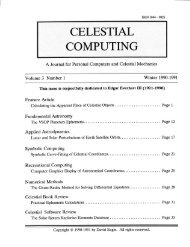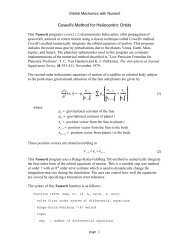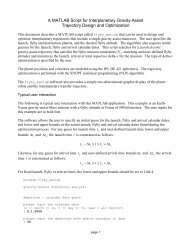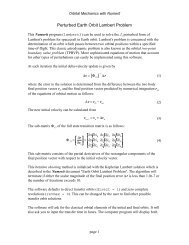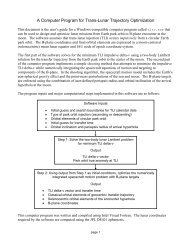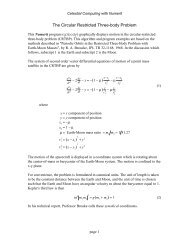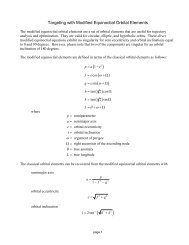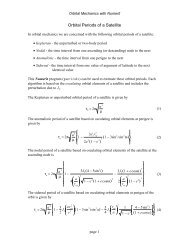Orbital Maneuvers - Orbital and Celestial Mechanics Website
Orbital Maneuvers - Orbital and Celestial Mechanics Website
Orbital Maneuvers - Orbital and Celestial Mechanics Website
Create successful ePaper yourself
Turn your PDF publications into a flip-book with our unique Google optimized e-Paper software.
<strong>Orbital</strong> <strong>Mechanics</strong> with MATLAB<br />
where g is the scalar acceleration of gravity at the location of the maneuver, is the<br />
instantaneous flight path angle, t ign is the ignition time of the maneuver <strong>and</strong> t bo is the burnout or<br />
termination time of the burn. The gravity loss occurs because the g sin term turns the vehicle<br />
away from the optimal thrust direction during a finite burn maneuver.<br />
The inertial delta-velocity added to the vehicle by the finite burn is given by<br />
i<br />
tbo<br />
tign ECI<br />
V T u dt<br />
The total acceleration of the spacecraft is a combination of “Keplerian” gravity <strong>and</strong> thrust<br />
acceleration according to the following expression:<br />
T a g u<br />
m In this equation T is the thrust level, m is the instantaneous mass of the vehicle <strong>and</strong> u ECI is the<br />
inertial unit pointing vector along which the thrust is applied. This script numerically integrates<br />
this system of nonlinear vector differential equations using the rkf78 function while accounting<br />
for the change in spacecraft mass due to propellant expenditure.<br />
The transformation of a unit pointing vector in the radial-tangential-normal (RTN) coordinate<br />
system centered at the spacecraft u RTN to an Earth-centered-inertial (ECI) unit pointing vector<br />
u ECI is given by the following operation:<br />
h r<br />
<br />
h r<br />
page 10<br />
ECI<br />
h r <br />
u h r u<br />
x x x<br />
<br />
ECI hy r y y RTN<br />
<br />
hz r z z<br />
In this matrix h is the angular momentum vector <strong>and</strong> all x, y <strong>and</strong> z components of these matrix<br />
elements are unit vectors.<br />
The RTN unit pointing vector at any mission time t is determined from the pitch <strong>and</strong> yaw angles<br />
as follows:<br />
sintcos t <br />
u RTN t cos t cos<br />
t <br />
sin<br />
t <br />
<br />
For the coplanar case modeled in this MATLAB script, the yaw or out-of-plane angle is<br />
always zero.<br />
The following is a typical user interaction with this script.




